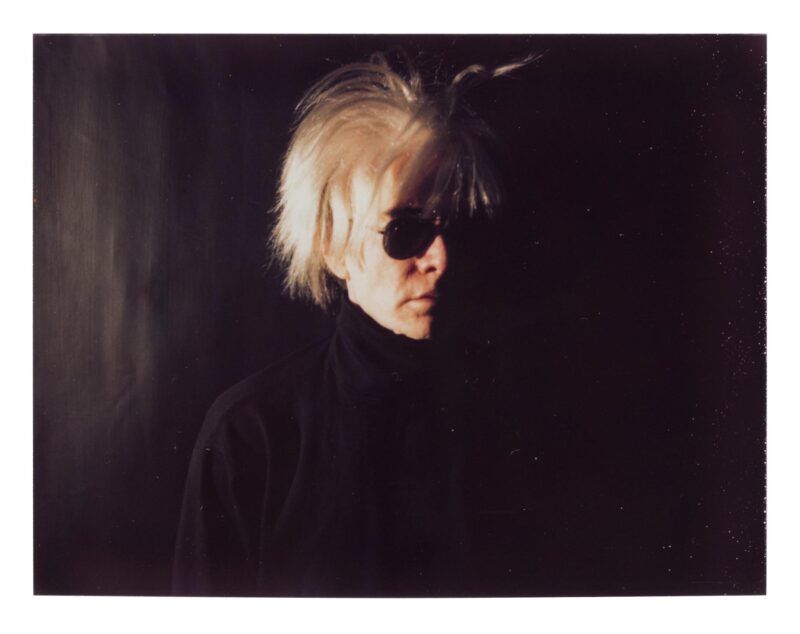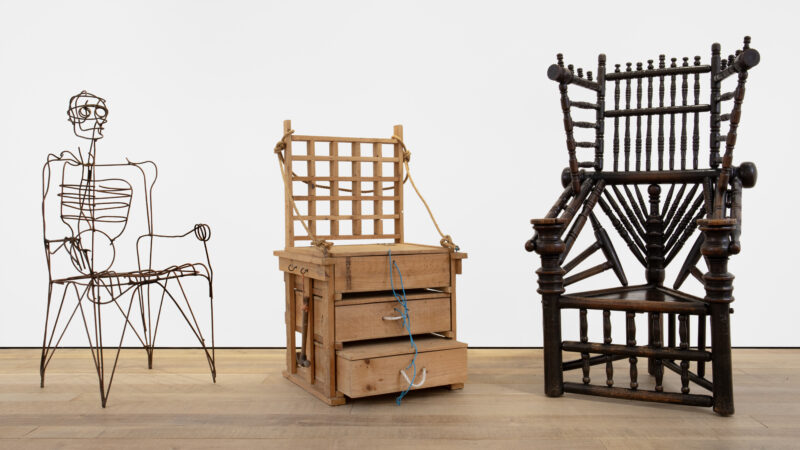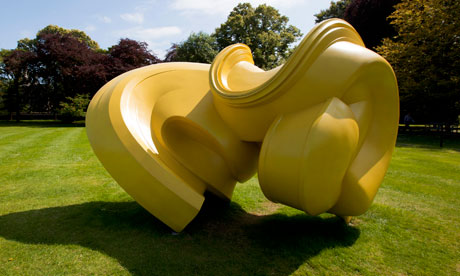
Outspan, 2010 by Tony Cragg: ‘Each piece is charged with a characteristic strength of power and direction.’ Photograph: Ivon Bartholomew
FAD didnt goto Edinburgh for the festival, so we missed the dreadful weather but The Guardian did Hurrah !
The show of Tony Cragg‘s sculptures at the Scottish National Gallery of Modern Art is rich, satisfying, beautifully installed and presents a more or less ideal survey of the past two decades of this prolific artist’s work. It begins outside with a brilliant yellow whorl that conflates hints of ear, sun and seashell, and continues indoors to the newest riffs on sprinters, daydreams, hedges and chips – not that nouns can ever give an impression of the quizzical nature of his work.
At 62, Cragg is the most internationally exhibited of that famous generation of British sculptors which includes Anish Kapoor and the Richards Wentworth, Long and Deacon. His work is various and versatile yet immediately recognisable. Each piece is charged with a characteristic strength of power and direction.
Verbs, indeed, get closer to the experience of his sculptures. Still as they are, cast in bronze or carved out of hulking lumps of marble, there is always an implicit sense of motion. And this motion is very often comic: the flight of a custard pie, the clumsy throwing of clay on a potter’s wheel, the spinning of plates, the squeezing of toothpaste. Forms are whipped, whirled and spun. The jelly shakes, the pile of plates is just about to topple.
The human form is conjured in many of the works in Edinburgh, a creature wobbling and faltering but somehow managing to hold its own in the vertical world. Something close to a portrait bust in bronze is burled about, nose, lips and chin spinning circular ridges in their wake. A bulging totem gyrates.
What you see has an affinity with geological growth, but with other organisms as well. Molluscs, mushrooms, something with the in-turned lips of a conch and the rib of a ram’s horn: the shapes are fused or plaited. And everything gets its twist.
How they were made, what they are made of: these sculptures speak of both. Cragg has always been a master of materials. He gets marble to look as soft as melting ice cream, and heavy metal to look as if it has escaped the laws of gravity. Distant Cousin, a creature that resembles a kind of prehistoric bipod midway through a game of Twister, turns out to be cast in fibreglass but somehow carries the weight and density of ancient onyx. And Cragg is always performing these curious illusions. The sculptures are hard but apparently soft, upright yet collapsing, dynamic and yet immobile. Perhaps there are a few too many of the latter, which take off from Renato Bertelli’s Continuous Profile of Mussolini from 1933, where the line of Il Duce’s profile is spun through three dimensions to make a solid gleaming head. Even the title of Cragg’s Constant Change acknowledges Bertelli. This immense silver figure appears to move when you move, its surface reflections shifting and undulating as you walk around it. It is a bright challenge to the old definition of sculpture.
It is good to see Cragg’s recent graphic work, especially the aquatints of molten steel forging a white river through the soot-black surface of the print. Associations with the industrial process (Cragg started out as a lab technician) are more pronounced than in his last British retrospective at Tate Liverpool in 2000, especially in the room full of cogs and cranks cast in combinations that evoke pots, pans and chimneys as well as exquisitely glazed Chinese ceramics.
The latest works depict onward motion as a horizontal force – a runner’s movements rippling through elbow and knee like some early futurist painting translated into bronze; a massive wooden form jetting forward as if about to take off into flight, an effect abetted by the lateral stripes in the wood. These are speeding blurs made momentarily solid.
One of these sculptures, above all, achieves something absolutely striking: a three-dimensional equivalent of that cartoon trope in which a single head appears to look both ways – right-left – all at once to signal total confusion. That humour that has been latent in Cragg’s art for so long bursts mirthfully out. It is a delight not often experienced in the solemn world of sculpture.
Sculpture dominates the Edinburgh art festival this year, and respect is due to Inverleith House for mounting the first Robert Rauschenberg show here in 30 years. It is a coup to have America’s first art-out-of-anything master in this beautiful gallery, even if one is oppressively aware of that fact. For the 37 works made between 1982 and 1998 (he died in 2008) get what power they have mainly as art historical relics: fragments of the prodigious but irregular output of this pioneer collagist of everyday stuff.
For those who associate Rauschenberg with the poetry of his 50s Combines – the goat yoked in its car tyre, the crow clattering out of an ominous canvas – there are some salient sculptures. Global Chute props an industrial pipe at a teasingly phallic angle, a steel arrow dangling from its tip. A ladder is crowned with an anthropomorphic cog. And the magnifying glass suspended inside a Keiller jar like some perfectly bottled specimen of ice or crystal speaks without words of the beauty of light.
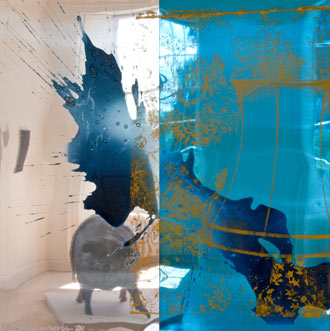
But most of the work is from the two-dimensional Borealis series in which sheets of steel, brass, bronze and aluminium are overlaid with images so that one sees the present world reflected among the tangle of motifs. A screen of lace is picked out of brass in slow tarnish; elephants, lanterns and skulls shimmer in mirrored aluminium. Look at the tree enamelled on steel and you see reflections of the real ones in the botanical gardens outside.
Pretty, spacey and anodyne, this is not work to stir the mind, and it’s no surprise to learn that these leavings have been assembled by the Rauschenberg Studio in conjunction with the Gagosian Gallery in New York – the recycler recycled as the pricey remnants of a tremendous career in US art.
The Scottish sculptor and collagist David Mach has filled all five floors of the City Arts Centre with his interpretations of the King James Bible. Even without entering the building you can see how this will go from the three colossal crucifixes in the gallery windows: steel girders mounted with larger-than-life figures sprouting nails in the manner of Clive Barker’s hell-raising Pinhead.
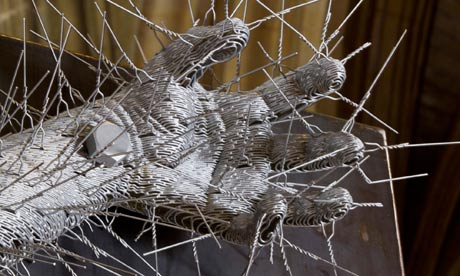
There are more enormities inside, including the Bruce Willis crucifixion sniggeringly entitled Die Harder and many vast collages based on action movies in which thousands of figures flee impending disaster. This is Mach’s one conceit, this borrowing from Hollywood, although his Judgement Day and Apocalypse Now are relocated to contemporary Britain.
Collage has the potential for extreme disjuncture of content and scale. Mach partakes of neither. His teeming crowd scenes are scaled so the perspective always works (except for the plague of frogs), and the juxtapositions – suburb with shanty town, for example – aren’t so piquant when the world is turned upside down. Once you have the concept of the biblical epic you can guess the content.
Mach was once such an inventive artist, his fluid sculptures formed out of thousands of magazines, coathangers, matches, tyres, the material always aptly and tellingly deployed. Something has gone wrong of late. Jesus surfing the waves, hell as Disneyland, the flood as a cataclysm of upset picnics, crying babies and zoo animals unleashed: each idea is literal, each collage coarse and tawdry.
This article was amended on 9 August
guardian.co.uk © Guardian News & Media Limited 2010
Published via the Guardian News Feed plugin for WordPress.
